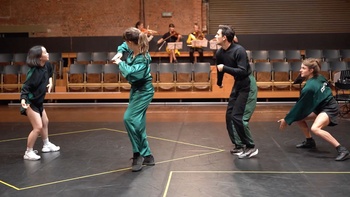The work of the German choreographer and Kaaitheater artist-in-residence Vera Tussing is characterized by a focus on all the senses and the organization of a personal encounter between the audience and the performer. Tactile Quartet(s) literally plays the audience.
_Lucien_Lepoutre.jpg?style=W3sianBlZyI6eyJxdWFsaXR5Ijo3MH19LHsicmVzaXplIjp7ImZpdCI6Imluc2lkZSIsIndpZHRoIjoxMjk2LCJoZWlnaHQiOjg2NCwid2l0aG91dEVubGFyZ2VtZW50Ijp0cnVlfX1d&sign=3c978c2498727077741a2624724e18cba115399a897dcc470b909acd27669adb)
© Lucien Lepoutre
Vera Tussing's Tactile Quartet(s) literally plays the audience
Tactile Quartet(s) literally feels its way around the dynamism between a dance quartet and a music quartet, and the dancers and musicians literally touch the audience. Vera Tussing – who previously presented Mazing (2016) and The Palm of Your Hand (2017) at Kaaitheater – conceives of group creations as an exercise in the way in which people in society always function in group relationships. During the rehearsals, the dancers created a common language, and the Quatuor MP4 has for the past ten years worked in a fixed structure that suits the strictly formalized quartet genre. “The processes in these two quartets are opened up to the audience, with which we create various alliances,” Tussing tells us. “We use touch to make contact and then we wait and see what happens. At the end of the performance, we also invite four audience members onstage whose arms will be played by the musicians: the tactile quartet.”
Some audience members will be eager to join in, but others might not want to.
Vera Tussing: We realize that, of course. It is a good thing for performers to learn how to deal with the different ways in which the audience reacts. Performers are generally not extensively trained in silent communication with the audience. It is not an obvious choice to ask musicians to play the arms of an audience member. But because interaction with the audience was an important element of my earlier work, we sharpened the focus on that sensitivity here. If somebody does not want to participate, it is not a problem. The performers have to give the viewers the space to decide how they would like to be involved. We also explore the frictions that are by definition part of group processes, and particularly those between different groups. Friction sheds light on how we position ourselves towards one another.

© Lucien Lepoutre
What do you think of the way contemporary people deal with physical contact and tactility?
Tussing: People are always doing something with their hands in one way or another: fiddling, smoking, twisting their hair… In that respect, swiping across your smartphone is part of age-old behaviour. Children discover the world by touching everything. The smartphone distances that world from touch, but also creates more links.
Even thinking of #MeToo leads to the conclusion that we have not perhaps reflected sufficiently on how we function as part of a group, and how we have to negotiate touch.
What sort of music suits all this?
Tussing: Melodic compositions work really well for our tactile approach. Typical quartets like Der Tod und das Mädchen by Schubert or “The American Quartet” by Dvorák are juxtaposed with early twentieth-century work by Florence Price. Music collaborator and composer Michael Picknett has provided the improvisation assignments and a number of short compositions. The piece that recurs most often is Entr’acte, written in 2011 by the American composer Caroline Shaw. Our objective is a synthetic experience: when the musicians play an arm like a violin, you can feel the music. It is tactile karaoke.
Read more about: Podium
Fijn dat je wil reageren. Wie reageert, gaat akkoord met onze huisregels. Hoe reageren via Disqus? Een woordje uitleg.